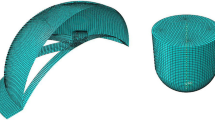Abstract
This paper is based on the energy absorption of Expanded polystyrene (EPS) into a motorcycle helmet to evaluate the impact resistance on a flat anvil in the shock absorption test of QCVN:2008. The paper is divided into two sections: In the first section, the EPS liner of either helmet is experimentally determined its density and stress-strain curve used in FEA models. The other is tested shock absorption at SMEQ in order to measure the acceleration value at the peak position, 3 ms and 6 ms of acceleration curve which is required in the standard. In the second section, a basic model with three layers (head form, EPS, and shell) is built in Solidworks and simulated in LS-DYNA under experimental conditions. After compared with experimental values, the model is optimized to obtain an error of less than 5%. In order to investigate the behavior of this model with different thicknesses, the EPS layer thickness of the optimized model is modified from 10 to 20 mm. As a result, the acceleration values depend on the EPS layer thickness, the peak acceleration increase rapidly in proportion to the thickness from 10 to 14 mm and then the acceleration decreases to a limit value of 20 mm thickness. The simulation result also shows that the stress of the ABS shell is concentrated in at the impact point which is the center of the circle and slightly decreases from the center. By using simulation technology in the impact tests, the shock absorption of EPS is controlled by its thickness which is 16 mm or more for better protection.
Access this chapter
Tax calculation will be finalised at checkout
Purchases are for personal use only
Similar content being viewed by others
References
National Traffic Safety Committee Homepage. http://antoangiaothong.gov.vn/. Last accessed 20 July 2020
World Health Origination (WHO): Global status report on road safety 2018. Table A6: helmet laws, enforcement and wearing rates by country/area, 346–357 (2016)
Thompson, D.C., Rivara, F., Thompson, R.: Helmets for preventing head and facial injuries in bicyclists. In: Cochrane Database of Systematic Reviews, (1999)
Wensu, C., Hong, H., Dylan, H., Yanchao, S., Jian, C., Zhong-Xian, L.: Static and dynamic mechanical properties of expanded polystyrene. Mater. Des. 69, 170–180 (2015)
Michael, F.: Ashby: Materials Selection in Mechanical Design, 2nd edn. Butterworth-Heinemann, New York, NY, USA (2011)
Shannon, G.K., Stephanie, J.B., Alyssa, L.D., Craig, A.G., Gunter, P.S.: Age Does Not Affect the Material Properties of Expanded Polystyrene Liners in Field-Used Bicycle Helmets. J. Biomech. Eng. 138 (2016)
Tso-Liang, T., Cho-Chung, L. and Van-Hai, Ng.: Innovative design of bicycle helmet liners. J. Mater.: Des. Appl. 228, 341–351 (2013)
Khoa, H.B., Vinh, P.Q., Hung, C.P., Thanh. P.M., Son, H.L. P., Quoc, N.T.M., Long, N.T.: Research a numerical method to determine the impact resistance and shock absorption of motorcycle helmet. In: The 12th National Conference on Solid Mechanics, 770–777 (2015)
Andrej, Š., Jernej, K., Matija, F.: Parameter identification for a low-density-foam material model using numerical optimisation procedures. Eng. Comput.: Int. J. Comput.-Aided Eng. Softw. 31, 1532–1549 (2014)
Gerhard, S., Gavin, V., Virendra, C.: Material model validation of a high efficient energy absorbing foam. In: 5th LS-DYNA Forum, 3 (2006)
Mills, N.J., Gilchrist, A.: Finite-element analysis of bicycle helmet oblique impacts. Int. J. Impact Eng 35, 1087–1101 (2008)
Author information
Authors and Affiliations
Editor information
Editors and Affiliations
Rights and permissions
Copyright information
© 2021 The Author(s), under exclusive license to Springer Nature Singapore Pte Ltd.
About this paper
Cite this paper
Huynh, L.P.S., Vo, T.A., Nguyen, T.L. (2021). Investigate the Energy Absorption Capacity of EPS with Different Thicknesses in the Motorcycle Helmet. In: Bui, T.Q., Cuong, L.T., Khatir, S. (eds) Structural Health Monitoring and Engineering Structures. Lecture Notes in Civil Engineering, vol 148. Springer, Singapore. https://doi.org/10.1007/978-981-16-0945-9_42
Download citation
DOI: https://doi.org/10.1007/978-981-16-0945-9_42
Published:
Publisher Name: Springer, Singapore
Print ISBN: 978-981-16-0944-2
Online ISBN: 978-981-16-0945-9
eBook Packages: EngineeringEngineering (R0)




